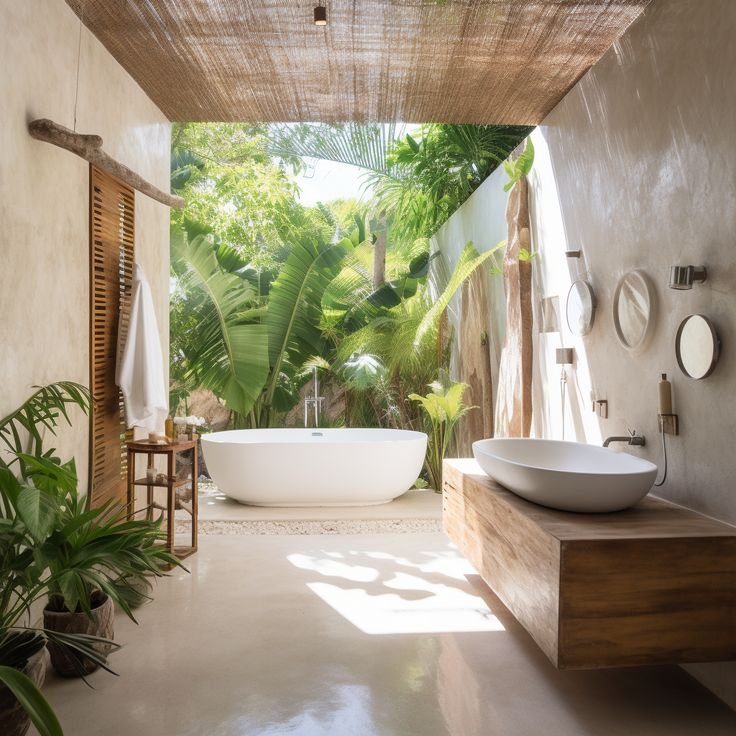Eco-Friendly Bathroom Upgrades: 10 Sustainable Changes for a Greener Home

Introduction
Table of Contents
ToggleIn today’s world, sustainability is more important than ever, and every room in our homes presents an opportunity to reduce our environmental impact. The bathroom, often one of the most resource-intensive spaces in a home, is no exception. With water consumption, energy use, and plastic waste at the forefront of environmental concerns, upgrading your eco-friendly bathroom can make a significant difference.
Transforming your bathroom into a sustainable sanctuary is not just beneficial for the environment; it also improves your quality of life. Eco-friendly upgrades can lead to lower utility bills, healthier living spaces, and a more aesthetically pleasing and functional bathroom. From small adjustments to complete renovations, the possibilities for making your bathroom greener are endless.
This guide explores ten impactful changes you can make to create an eco-friendly bathroom. These changes will focus on water conservation, energy efficiency, sustainable materials, and waste reduction. Whether you’re planning a minor makeover or a full-scale remodel, these ideas will inspire you to take steps toward a greener, more sustainable home.
1. Install Water-Efficient Fixtures
Water usage is one of the biggest environmental concerns in bathrooms. Upgrading to water-efficient fixtures can drastically reduce your water consumption.
- Low-Flow Toilets: Replace standard toilets with low-flow or dual-flush models, which use significantly less water per flush.
- Aerated Showerheads: Install water-saving showerheads that mix air with water to maintain pressure while reducing usage.
- Sensor Faucets: Consider touchless faucets that shut off automatically when not in use.
These fixtures not only conserve water but also contribute to lower water bills.
2. Opt for Energy-Efficient Lighting
Bathrooms are often lit for extended periods, making energy-efficient lighting a crucial upgrade.
- LED Bulbs: Switch to LED lighting, which consumes less electricity and lasts much longer than traditional incandescent bulbs.
- Motion Sensors: Install motion sensors or timers to ensure lights are only on when needed.
- Natural Light: Maximize the use of natural light with skylights or larger windows to reduce the need for artificial lighting during the day.
Energy-efficient lighting reduces electricity consumption while creating a bright, inviting atmosphere.
3. Use Sustainable Materials
Renovating your bathroom with sustainable materials can reduce your carbon footprint and create a healthier space.
- Recycled Tiles: Choose tiles made from recycled glass or ceramic for your walls and floors.
- FSC-Certified Wood: Use sustainably sourced wood for vanities, cabinets, and shelving.
- Eco-Friendly Paint: Opt for low-VOC (volatile organic compound) paints to minimize harmful emissions.
Sustainable materials are not only environmentally friendly but also add a unique, stylish touch to your bathroom.
4. Incorporate Water-Saving Habits
Adopting mindful habits can complement your eco-friendly upgrades and further reduce water waste.
- Turn Off the Tap: Avoid running water while brushing your teeth or shaving.
- Shorter Showers: Aim to reduce shower time by a few minutes to conserve water.
- Collect Greywater: Use a greywater system to recycle water from sinks and showers for flushing toilets or irrigation.
These simple habits, combined with efficient fixtures, make a significant impact over time.
5. Choose Eco-Friendly Toiletries
The bathroom is a hotspot for single-use plastics and chemical-laden products. Switch to eco-friendly toiletries to reduce waste and exposure to harmful substances.
- Bar Soaps: Replace liquid soap in plastic bottles with package-free bar soaps.
- Biodegradable Toothbrushes: Use bamboo toothbrushes instead of plastic ones.
- Sustainable Packaging: Opt for toiletries packaged in glass, aluminum, or compostable materials.
Making these swaps reduces plastic waste and supports sustainable brands.
6. Install a Greywater Recycling System
A greywater recycling system is an advanced upgrade that can dramatically improve your bathroom’s sustainability.
- How It Works: Greywater systems collect and filter wastewater from sinks, showers, and washing machines for reuse in flushing toilets or watering plants.
- Benefits: This reduces the demand for fresh water and decreases the strain on local water treatment facilities.
- Installation: While this may require professional installation, the long-term environmental and financial benefits are worth the investment.
This innovative solution is ideal for homeowners seeking significant water conservation.
7. Add Plants for Natural Air Purification
Indoor plants can enhance your bathroom’s eco-friendly vibe while improving air quality.
- Air-Purifying Plants: Choose plants like aloe vera, spider plants, or peace lilies that thrive in humid environments.
- Decorative Appeal: Use plants to add a touch of greenery and warmth to your bathroom décor.
- Low-Maintenance Options: Select low-maintenance plants if you have limited time for care.
Plants not only purify the air but also create a calming, spa-like atmosphere.
8. Use Renewable Energy for Heating
Bathrooms often rely on energy-intensive systems for heating. Switching to renewable energy options can reduce your reliance on fossil fuels.
- Solar Water Heaters: Install solar panels to heat water for showers and sinks.
- Radiant Floor Heating: Use energy-efficient radiant floor heating powered by renewable energy sources.
- Energy-Efficient Ventilation: Ensure your bathroom has proper ventilation systems to maintain temperature efficiently.
Renewable energy solutions lower your utility bills and carbon emissions.
9. Reduce Waste with a Recycling Bin
Most bathrooms lack a dedicated recycling bin, leading to unnecessary landfill waste.
- Recyclables: Place a small recycling bin for items like toilet paper rolls, plastic bottles, and packaging.
- Composting: If you use compostable toiletries, consider adding a compost bin for bathroom waste.
- Education: Label bins clearly to encourage proper recycling habits among family members.
This simple addition promotes waste segregation and recycling awareness.
10. Support Eco-Friendly Brands
Finally, choose eco-friendly brands for bathroom essentials to ensure your purchases align with your sustainability goals.
- Organic Towels and Linens: Use towels made from organic cotton or bamboo.
- Sustainable Cleaning Products: Switch to biodegradable, non-toxic cleaners.
- Refillable Products: Opt for brands that offer refillable containers for soaps, shampoos, and cleaning supplies.
Supporting eco-conscious brands fosters a market for sustainable products and practices.
Conclusion
Creating an eco-friendly bathroom is a meaningful step toward a sustainable home. From installing water-saving fixtures to adopting waste-reduction habits, every change you make contributes to conserving resources and protecting the environment. While some upgrades may require an initial investment, the long-term benefits for both the planet and your wallet make them worthwhile.
By implementing the ten changes outlined in this guide, you can transform your bathroom into a space that aligns with your environmental values. Remember, sustainability is a journey—start with one or two upgrades and build on your efforts over time. Your eco-friendly bathroom not only sets an example for others but also enhances your home’s functionality and charm, proving that sustainability and style can go hand in hand.





